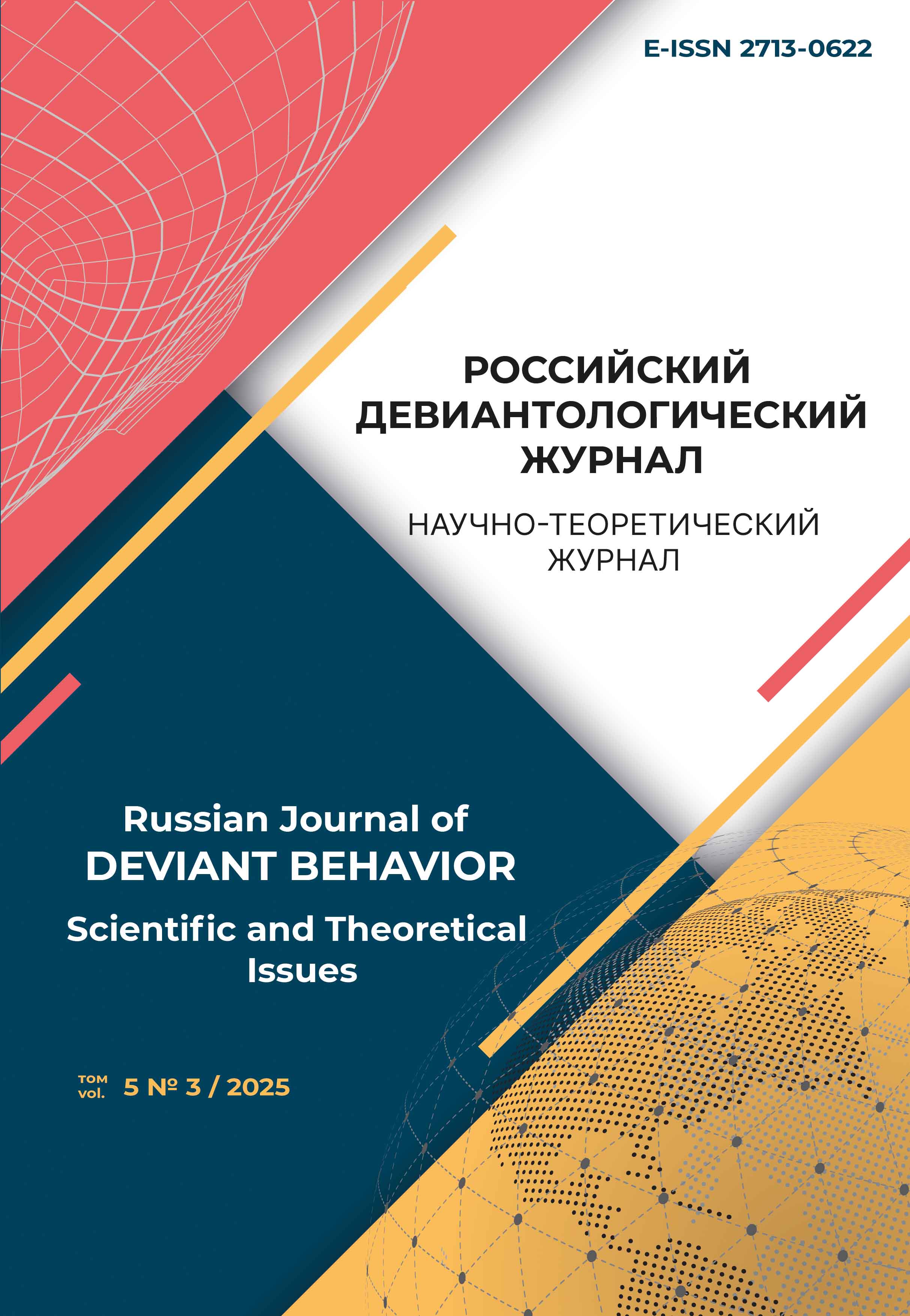Kazan, Kazan, Russian Federation
UDC 159.99
Introduction. In recent decades, there has been a worrying trend – an increase in the number of adolescents at risk of deviant behavior. Specialists in the field of education and law enforcement agencies are responsible for improving psychological and pedagogical work with such individuals. The solution to this problem lies in expanding scientific understanding of the individual psychological characteristics of adolescents prone to deviant behavior. The aim of the study is to examine the individual psychological characteristics of adolescents at risk through the prism of somatic characteristics of their mental state. Research methods. Neurophysiological and psychophysiological studies of neurotransmitter and hormone levels, as well as measurement of electroencephalographic brain activity (EEG). The study sample involved 30 adolescents at risk. Results. Neurophysiological and psychophysiological characteristics specific to the risk group have been identified based on the indicators such as catecholamine hormone levels, 17-hydroxyprotoprosterone levels, and theta brain activity (EEG). These characteristics have been interpreted psychologically in the context of the prerequisites for deviant behavior. The conclusions of the study are directed towards the organisation of preventive and proactive work with adolescents classified as being at risk. Further directions for theoretical and applied research into the individual psychological characteristics of this category of minors have been outlined.
risk group, adolescence, aggressive behavior, prevention, anxiety
1. Aptikieva, L. R. (2019). Razlichiya podrostkov «gruppy riska» i tipichnyh podrostkov: psihologo-pedagogicheskij aspekt. Vestnik Orenburgskogo gosudarstvennogo universiteta, 3 (221), 6–14.
2. Gilinskij, Ya. I. (2009). Sociologiya deviantnosti (novelly i perspektivy). Sociologicheskie issledovaniya, 8 (304), 70–73.
3. Dement'eva, I. F. (2006). Socializaciya detej v sem'e v usloviyah transformacii: tendencii, faktory, deter¬minanty: avtoref. dis. … d. sociol. n. Moskow.
4. Iznak, A. F., Iznak, E. V., Damyanovich, E. V., Olejchik, I. V. (2023). EEG-korrelyaty suicidal'nyh namerenij u bol'nyh depressiej, bolevshih i ne bolevshih COVID-19. Zhurnal nevrologii i psihi-atrii im. S.S. Korsakova, 123 (11-2), 92–95. https://doi.org/10.17116/jnevro202312311292
5. Machinskaya, R. I., Farber, D. A. (2023). Regulyaciya povedeniya i kognitivnoj deyatel'nosti v pod-rostkovom vozraste. Mozgovye mekhanizmy: monografiya. Moskow: Moskovskij psihologo-social'nyj universitet.
6. Machinskaya, R. I., Zaharova, M. N., Lomakin, D. I. (2020). Regulyatornye sistemy mozga u podrost¬kov s priznakami deviantnogo povedeniya. Mezhdisciplinarnyj analiz. Fiziologiya cheloveka, 46 (3), 37–55. https://doi.org/10.31857/S0131164620030121
7. Nevskij, I. A. (1993). Uchitelyu o detyah s otkloneniyami v povedenii. Moskow: Izdatel'stvo «Prosve-shchenie».
8. Rean, A. A. (2015). Faktory riska deviantnogo povedeniya: semejnyj kontekst. Nacional'nyj psiho-logicheskij zhurnal, 4 (20), 105–110.
9. Semenov, A. V. (2016). Nejrofiziologicheskie korrelyaty agressii i agressivnosti. Vestnik Kurganskogo gosudarstvennogo universiteta, 2 (41), 14–18.
10. Smelzer, N. (1994). Sociologiya (per. s angl.). Moskow: Izdatel'stvo «Feniks».
11. Suslonov, P. E. (2014). Teoretiko-metodologicheskie aspekty izucheniya social'noj psihologii politi-cheskogo ekstremizma i terrorizma. Gumanitarnye, social'no-ekonomicheskie i obshchest-vennye nauki, 8, 215–218.
12. Fel'dshtejn, D. I. (2008). Trudnyj podrostok. Moskow: Izdatel'stvo Moskovskogo psihologo-social'nogo instituta.
13. Husainova, S. V. (2021). Agressivnost' obuchayushchihsya kak faktor social'noj ustojchivosti. V R. H. Gil'meeva, L. A. Shibankova (red.), Gumanitarnyj vektor obrazovaniya v epohu cifrovizacii: materialy mezhdunarodnoj nauchno-prakticheskoj konferencii (g. Kazan', 22 sen¬tyabrya 2021 goda, str. 310–314). Kazan': Institut pedagogiki, psihologii i social'nyh problem.
14. Husainova, S. V., Chernova, E. O. (2023). Problemy organizacii metodicheskoj i profilakticheskoj raboty s nesovershennoletnimi. Kazanskij pedagogicheskij zhurnal, 3 (158), 213–218.
15. Chipan, A. A. (2023). Osnovnye podhody k rassmotreniyu nauchnogo ponyatiya «podrostki gruppy riska». Mir nauki, kul'tury, obrazovaniya, 4 (101), 197–202.
16. Andrew, J. M. (1981). Reading and Cerebral Dysfunction Among Juvenile Delinquents. Criminal Justice and Behavior, 8 (2), 131–144. https://doi.org/10.1177/009385488100800201 (Original work published 1981).
17. Baek, H., Posadas, C. E., & Kwak, D. H. (2022). Parental Management on Juvenile Delinquency through Low Self-control And Misperception. Deviant Behavior, 44 (4), 510–527. https://doi. org/10.1080/01639625.2022.2061390
18. Hayes, H. D. (1997). Using integrated theory to explain the movement into juvenile delinquency. Deviant Behavior, 18 (2), 161–184. https://doi.org/10.1080/01639625.1997.9968051
19. Jacobsen, S. K., & Zaatut, A. (2020). Quantity or Quality?: Assessing the Role of Household Struc¬ture and Parent-Child Relationship in Juvenile Delinquency. Deviant Behavior, 43 (1), 30–43. https://doi.org/10.1080/01639625.2020.1774241
20. Kroese, J., Bernasco, W., Liefbroer, A. C., & Rouwendal, J. (2020). Growing up in single-parent fami-lies and the criminal involvement of adolescents: a systematic review. Psychology, Crime & Law, 27 (1), 61–75. https://doi.org/10.1080/1068316X.2020.1774589
21. Lee, W., Moon, J., & Garcia, V. (2019). The Pathways to Desistance: A Longitudinal Study of Juve-nile Delinquency. Deviant Behavior, 41 (1), 87–102. https://doi.org/10.1080/01639625. 2018.1519138
22. Sun, W., Wang, M., Zheng, F., & Wang, Y. (2024). From Nurture to Deviance: A Study on Parenting Style and Juvenile Delinquency. Deviant Behavior, 46 (5), 639–655. https://doi.org/10.1080/01 639625.2024.2361051
23. Yoshii, N., Ishiwara, T., & Tani, K. (1964). Juvenile delinquents and their abnormal eeg’s (2) con-tinuous theta waves. Psychiatry and Clinical Neurosciences, 18 (2), 161–167. https://doi. org/10.1111/j.1440-1819.1964.tb00021.x















